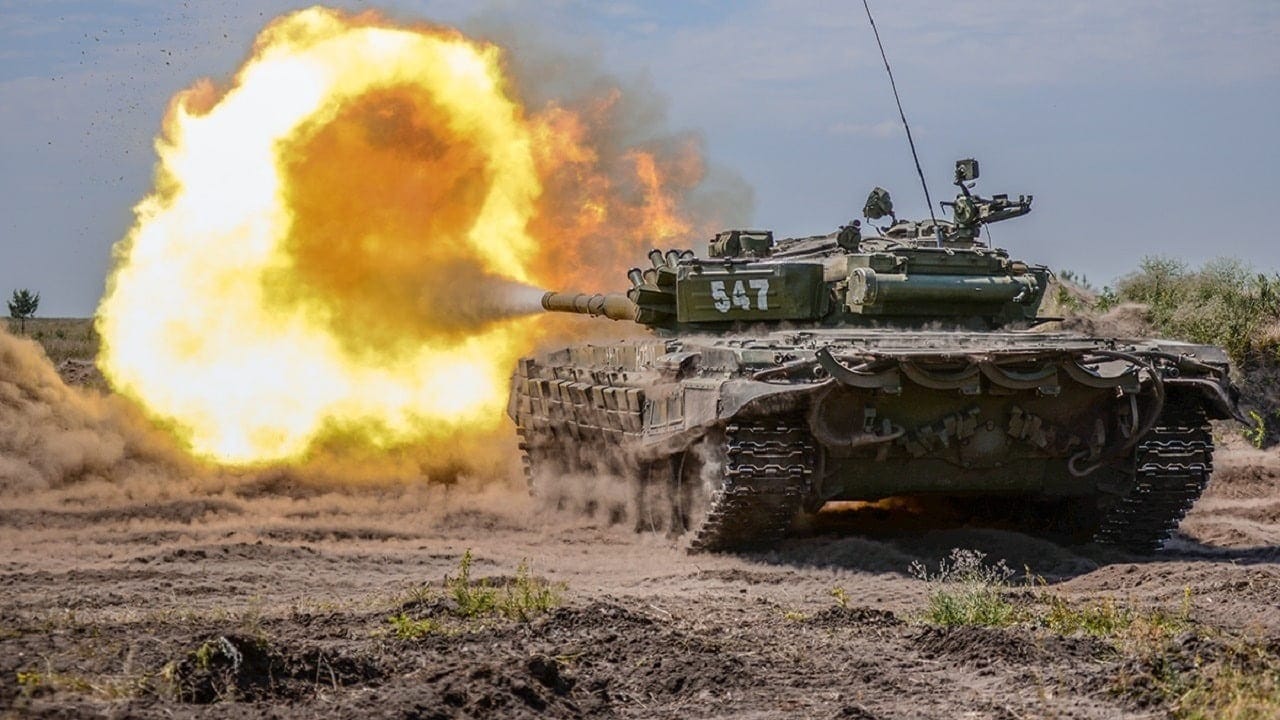Ukraine Has Some Really Interesting New Monuments: A Soviet T-34-85 tank – which had been part of a war memorial in the city of Lysychansk that honored the Red Army’s efforts in World War II to drive out the Nazi invader – was reportedly used in the recent fighting. While it didn’t appear that the tank was actually operational, it was still employed as a roadblock near the heart of the city. Video posted to YouTube showed that the tank, serial number 227, which had been installed on a special pedestal in the city in 1971, had received no damage in the fighting. The T-34 has since been abandoned by retreating Ukrainian forces.
That particular tank, which according to legend was raised from the bottom of the Siverskyi Donets river in the Loskutivka area, had been used as a propaganda symbol in the past. Beginning in November 2015, local citizens have painted it blue and yellow – the colors of the Ukrainian flag – on multiple occasions.
The late World War II-era T-34 tank from Lysychansk, armed with a heavy 85mm main gun, is far from the only Soviet-era memorial to draw scrutiny across Ukraine. In 2014, after the Russian incursions into Donbas and Crimea, the government in Kyiv adopted the law on “de-communization,” which called for the removal of such memorials to past Soviet leaders. Statues of Lenin were toppled while many city streets and parks were renamed accordingly.
It wasn’t just the Soviets who often sought to spread the “Great Russian Culture” throughout all of its territories. In the Imperial Russian era, Russian writers, composers, artists, and scientists were revered in Ukrainian cities – while Ukrainians were largely ignored. After the dissolution of the Soviet Union, little changed – but since 2014 there has been an effort to wipe away the Russian influence. Those efforts were ramped up after Russia launched its unprovoked and unwarranted invasion in February, and many notable monuments have been dismantled.
First to go was a monolithic bronze statue glorifying the so-called “Unification of Ukraine with Russia,” which has stood in the center of Kyiv since 1982. The monument was meant as a tribute to the Soviet – and Russian – concept of Ukraine as a “brotherly nation,” which also implied that Ukraine could not exist outside of “Greater Russia.” Following the 2014 annexation of Crimea, some activists painted a large crack on the large titanium arch that towered over the statue.
There is almost some irony that when the sculpture of the two workers – symbolizing Russia and Ukraine marching hand-in-hand – was being removed in April, the head of the one representing Russia broke off.
“The monument was installed in 1982, showing Ukrainian and Russian workers holding together the USSR emblem,” the Euromaidan Press reported on social media.
While Kyiv authorities were dismantling the monument “To the unification of Ukraine with Russia” today, the head of the Russian worker broke off.
The monument was installed in 1982, showing Ukrainian and Russian workers holding together the USSR emblem. pic.twitter.com/gFsGPu5W5d
— Euromaidan Press (@EuromaidanPress) April 26, 2022
“The Russian worker’s head came off when they tried to lift the sculpture,” Kyiv mayor Vitali Klitschko said in a statement. “In the same way, we have to pick up and expel the enemy and the Russian occupier from our land.”
Serhiy Myrhorodskyi, the now-86-year-old architect who had designed the statue and arch, supported the decision to tear down the arch, saying it was “the right thing to do. There is no friendship with Russia and there will not be any friendship for a long time as long as Putin and his gang are in this world. After they drop dead, maybe in 30 years, something will change.”
Myrhorodskyi suggested the bronze is melted down and used in a new monument dedicated to the Ukrainian motherland.
Another monument was one that honored the Pereiaslav Agreement of 1654 – which essentially allowed Russia to dominate Ukraine after the latter broke away from Polish domination – was also ordered dismantled.
It was further announced that some 60 streets and places around Kyiv would be renamed, including a subway station currently named to honor Leo Tolstoy. However, not all residents supported that decision.
Kyiv resident Ihor Serhiivych told the Guardian newspaper, “Only idiots could do this. If it were a Putin statue I would understand, but you have to differentiate between enemies and world-famous literature.”
The New Memorials: Russian Tanks
As the old memorials from the Soviet era come down, they’re being replaced by something from the ongoing war – namely destroyed Russian tanks and other military vehicles. These include the T-72s that were part of the Russian armored column that was destroyed in an ambush in the Kyiv suburb of Dmytrivka in late March.
Those Russian tanks failed to reach the Ukrainian capital, and many remain on the side of the road as a testament to Ukraine’s resolve. The vehicles have become something of a curiosity for locals, who come to pose for pictures. Some families bring their children to see the tanks as a reminder that their nation is still very much fighting for its freedom.
Though that armored column never reached Kyiv, some of the Kremlin’s other tanks and vehicles have since been towed to Saint Michael’s Square in the heart of the old city where they are now on display. It may be the closest that Russian President Vladimir Putin‘s forces ever actually get to their promised parade in Ukraine’s capital.
A Senior Editor for 1945, Peter Suciu is a Michigan-based writer who has contributed to more than four dozen magazines, newspapers and websites. He regularly writes about military hardware, firearms history, cybersecurity and international affairs. Peter is also a Contributing Writer for Forbes. You can follow him on Twitter: @PeterSuciu.

